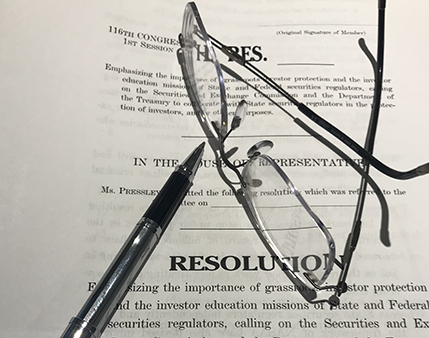Promissory Notes, Real Estate Investments and Ponzi Schemes Top the List
Cryptocurrency Contracts for Differences (CFDs) Identified as an Emerging Threat
- For Details: Top Investor Threats
WASHINGTON, D.C. (December 13, 2017) – A survey of state securities regulators conducted by the North American Securities Administrators Association (NASAA) revealed promissory notes to be the most frequently identified source of current investor complaints or investigations.
When asked to identify the top five current investment practices, products or schemes, 74 percent of regulators identified promissory notes as among their leading sources of complaints or investigations. Securities regulators from 50 U.S. jurisdictions responded to the survey, which was conducted in the spring and summer of this year.
“In today’s ongoing environment of low interest rates, the lure of high-interest-bearing promissory notes continues to tempt investors, especially seniors and others living on a fixed income,” said Joseph P. Borg, NASAA President and Alabama Securities Commission Director.
Used generally by companies to raise capital, legitimate promissory notes are marketed and sold almost exclusively to sophisticated or corporate investors with the resources to research the companies issuing the notes and to determine whether the issuers have the capacity to pay the promised interest and principal. Promissory notes may require registration as securities with federal and state securities regulators.
Borg noted that average investors should be cautious about offers of promissory notes with a duration of nine months or less, which in some circumstances do not require registration. Short-term notes that appear to be exempt from securities registration have been the source of most – though not all – of the fraudulent activity involving promissory notes identified by regulators. According to NASAA’s 2017 enforcement report, based on 2016 data, state securities regulators reported 138 formal enforcement actions involving promissory notes.
Fifty-four percent of state securities regulators identified both real estate investments and Ponzi/pyramid schemes as the second-most frequent source of current complaints or investigations. Oil and gas-related investments or interests were the third most cited source of complaints or investigations, identified by 50 percent of regulators. Affinity fraud was identified by 28 percent of the regulators, followed by variable annuity sales practices, identified by 26 percent.
Emerging Threats
Separately, NASAA’s Enforcement Section identified three emerging threats that investors should watch for in 2018: initial coin offerings (ICOs), cryptocurrency contracts for difference (CFD), and identity theft for purposes of depleting investment accounts, especially among senior investors.
“Technology, and in some instances the criminal misuse of technology, is at the heart of each of the emerging threats investors are likely to face in the coming year,” said Keith Woodwell, Utah Securities Director and NASAA Enforcement Section chair.
Woodwell noted that with mounting regulatory pressure on binary options, fraudsters are seeking other products to pitch investors. State and provincial securities regulators believe that these fraudsters are launching a new wave of schemes involving ICOs and CFDs that use cryptocurrencies as the underlying investment.
CFDs are complex financial instruments that enable an investor to speculate on the price of an underlying asset and can be highly leveraged, which multiplies the impact of price changes on profits and losses. Cryptocurrency CFDs allow investors to speculate on price changes in highly volatile cryptocurrency such as Bitcoin or Ethereum. CFDs, which are prohibited from being sold to U.S. citizens or residents, are marketed through Internet platforms and regulators caution that some of these platforms can be fraudulent themselves. “These speculative, high-risk products are prohibited in the United States for a reason; they are not suitable for investors,” Woodwell said. “There are red flags waving everywhere.”
“All investments involve a degree of risk. Investors can help protect themselves by taking time to research both the investment product and the person selling it. It’s best to learn before you get burned,” Borg said.
State and provincial securities regulators offer a wealth of free investor education materials and can help investors research the background of those selling or advising the purchase of an investment. Background information on each of this year’s top investor threats, as well as contact information for all state and provincial securities regulators, can be found on NASAA’s website, www.nasaa.org.
For More Information:
Bob Webster | Director of Communications
202-737-0900










